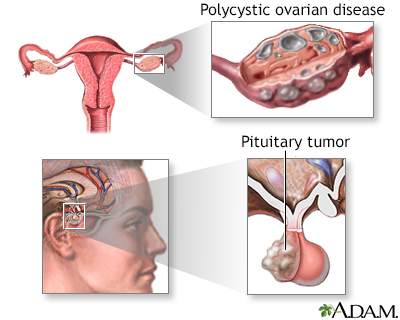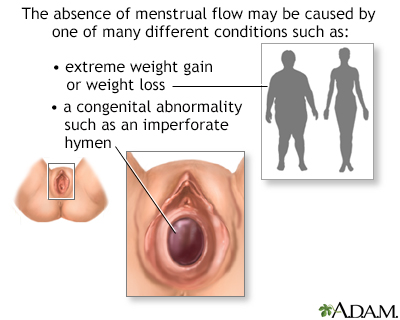
Amenorrhea - secondary; No periods - secondary; Absent periods - secondary; Absent menses - secondary; Absence of periods - secondary
Absence of a woman's monthly menstrual period is called amenorrhea. Secondary amenorrhea is when a woman who has been having normal menstrual cycles stops getting her periods for 6 months or longer.



Secondary amenorrhea can occur due to natural changes in the body. For example, the most common cause of secondary amenorrhea is pregnancy. Breastfeeding and menopause are also common, but natural causes.
Women who take birth control pills or who receive hormone shots such as Depo-Provera may not have any monthly bleeding. When they stop taking these hormones, their periods may not return for more than 6 months.
You are more likely to have absent periods if you:
Other causes include:
Also, procedures such as a dilation and curettage (D and C) can cause scar tissue to form. This tissue may cause a woman to stop menstruating. This is called Asherman syndrome. Scarring may also be caused by some severe pelvic infections.
In addition to having no menstrual periods, other symptoms can include:
If amenorrhea is caused by a pituitary tumor, there may be other symptoms related to the tumor, such as vision loss and headache.
A physical exam and pelvic exam must be done to check for pregnancy. A pregnancy test will be done.
Blood tests may be done to check hormone levels, including:
Other tests that may be performed include:
Treatment depends on the cause of amenorrhea. Normal monthly periods most often return after the condition is treated.
A lack of menstrual period due to obesity, vigorous exercise, or weight loss may respond to a change in exercise routine or weight control (gain or loss, as needed).
The outlook depends on the cause of amenorrhea. Many of the conditions that cause secondary amenorrhea will respond to treatment.
See your primary health care provider or women's health care provider if you have missed more than one period so you can get diagnosed and treated, if needed.
Bulun SE. Physiology and pathology of the female reproductive axis. In Melmed S, Auchus RJ, Goldfine AB, Koenig RJ, et al. Williams Textbook of Endocrinology. 14th ed. Philadelphia, PA: Elsevier; 2020:chap 17.
Cameron S. Menstruation and amenorrhoea. In: Magowan B, ed. Clinical Obstetrics and Gynaecology. 5th ed. Elsevier; 2023:chap 4.
Lobo RA. Primary and secondary amenorrhea and precocious puberty. In: Gershenson DM, Lentz GM, Valea FA, Lobo RA, eds. Comprehensive Gynecology. 8th ed. Philadelphia, PA: Elsevier; 2022:chap 36.
BACK TO TOPReview Date: 4/16/2024
Reviewed By: John D. Jacobson, MD, Professor Emeritus, Department of Obstetrics and Gynecology, Loma Linda University School of Medicine, Loma Linda, CA. Also reviewed by David C. Dugdale, MD, Medical Director, Brenda Conaway, Editorial Director, and the A.D.A.M. Editorial team.

|
A.D.A.M., Inc. is accredited by URAC, also known as the American Accreditation HealthCare Commission (www.urac.org). URAC's accreditation program is an independent audit to verify that A.D.A.M. follows rigorous standards of quality and accountability. A.D.A.M. is among the first to achieve this important distinction for online health information and services. Learn more about A.D.A.M.'s editorial policy, editorial process and privacy policy. A.D.A.M. is also a founding member of Hi-Ethics and subscribes to the principles of the Health on the Net Foundation (www.hon.ch). |
The information provided herein should not be used during any medical emergency or for the diagnosis or treatment of any medical condition. A licensed medical professional should be consulted for diagnosis and treatment of any and all medical conditions. Call 911 for all medical emergencies. Links to other sites are provided for information only -- they do not constitute endorsements of those other sites. © 1997- A.D.A.M., Inc. Any duplication or distribution of the information contained herein is strictly prohibited.